
What is Tillite? Tillite is a type of sedimentary rock formed from ancient glacial deposits. It’s essentially a rock made up of various sizes of debris, including boulders, pebbles, and sand, all cemented together by finer materials like clay or silt. This unique rock tells a story of Earth's past climates, specifically periods when glaciers covered large parts of the planet. Why is Tillite important? It provides crucial evidence for the theory of continental drift and helps scientists understand past ice ages. Where can you find Tillite? Tillite deposits are found worldwide, from Antarctica to the Himalayas, making them a global geological treasure.
What is Tillite?
Tillite is a fascinating type of sedimentary rock formed from ancient glacial deposits. It provides crucial insights into Earth's climatic history. Here are some intriguing facts about this unique rock.
-
Tillite forms from glacial till: Glacial till is the unsorted material left behind by retreating glaciers. When this material gets compacted and cemented over time, it becomes tillite.
-
Tillite indicates past glaciations: The presence of tillite in a region suggests that area was once covered by glaciers, offering clues about Earth's climatic past.
-
Tillite contains various rock fragments: This rock can include a mix of clay, sand, gravel, and boulders, all cemented together.
-
Tillite is found worldwide: From Antarctica to North America, tillite deposits are scattered across the globe, marking ancient glacial activity.
-
Tillite can be very old: Some tillite formations date back over 2 billion years, providing a window into Earth's distant past.
How is Tillite Formed?
Understanding the formation of tillite helps us appreciate its significance. The process involves several stages, each contributing to the rock's unique characteristics.
-
Glacial movement: As glaciers move, they pick up and carry various rock fragments and sediments.
-
Deposition: When glaciers melt, they deposit this material, known as glacial till, in layers.
-
Compaction: Over time, the weight of overlying materials compresses the till, squeezing out water and air.
-
Cementation: Minerals precipitate from groundwater, binding the sediments together to form solid rock.
-
Lithification: The combined processes of compaction and cementation transform loose till into hard tillite.
Types of Tillite
Tillite comes in different forms, each with distinct features. These variations provide valuable information about the conditions under which they formed.
-
Lodgement tillite: Formed directly beneath glaciers, this type is compact and well-cemented.
-
Ablation tillite: Created from material left behind as glaciers melt, it tends to be less compact and more loosely cemented.
-
Flow tillite: Resulting from glacial meltwater flows, this type often shows signs of sorting and layering.
-
Deformation tillite: Formed by the shearing and folding of glacial till during glacial movement, it exhibits complex structures.
Significance of Tillite in Geology
Tillite plays a crucial role in geological studies, offering insights into Earth's history and climatic changes.
-
Paleoclimatology: Tillite helps scientists reconstruct past climates, revealing periods of extensive glaciation.
-
Plate tectonics: The distribution of tillite deposits supports the theory of continental drift, showing how continents have moved over time.
-
Stratigraphy: Tillite layers provide important markers in the geological record, helping to date other rock formations.
-
Mineral exploration: Tillite can contain valuable minerals, making it a target for mining activities.
-
Environmental studies: Understanding tillite formation helps predict the behavior of modern glaciers and their impact on the environment.
Famous Tillite Formations
Some tillite formations are particularly well-known, offering spectacular examples of this unique rock.
-
Dwyka Tillite: Found in South Africa, this formation dates back to the late Paleozoic era and is one of the most extensive tillite deposits.
-
Gowganda Tillite: Located in Canada, this formation is over 2 billion years old, providing evidence of ancient glaciation.
-
Pleistocene Tillite: Found in North America and Europe, these deposits date back to the last Ice Age, around 2.6 million to 11,700 years ago.
-
Beacon Supergroup: In Antarctica, this formation includes tillite layers that offer clues about the continent's glacial history.
-
Huronian Supergroup: Located in Ontario, Canada, this formation contains some of the oldest known tillite, dating back to the Paleoproterozoic era.
Tillite in Modern Research
Modern research continues to uncover new information about tillite, enhancing our understanding of Earth's history.
-
Climate change studies: Tillite provides a long-term perspective on climate change, helping scientists predict future trends.
-
Glacial dynamics: Studying tillite helps researchers understand how glaciers move and interact with the landscape.
Tillite remains a vital tool for geologists, offering a glimpse into Earth's glacial past and helping to unravel the complexities of our planet's history.
Tillite's Fascinating Story
Tillite's story is a captivating blend of geology and history. This sedimentary rock, formed from ancient glacial deposits, offers a unique glimpse into Earth's climatic past. Found on every continent, it serves as a testament to the planet's dynamic changes over millions of years. Tillite's composition, a mix of clay, sand, and gravel, tells tales of ancient glaciers that once roamed the Earth. Its presence in regions like Antarctica and the Himalayas highlights the vast reach of these ancient ice sheets. Beyond its geological significance, tillite also plays a role in understanding past climates, helping scientists predict future climate patterns. Whether you're a geology enthusiast or just curious about Earth's history, tillite's story is a reminder of the ever-changing nature of our planet. Dive into the world of tillite and uncover the secrets of Earth's glacial past.
Was this page helpful?
Our commitment to delivering trustworthy and engaging content is at the heart of what we do. Each fact on our site is contributed by real users like you, bringing a wealth of diverse insights and information. To ensure the highest standards of accuracy and reliability, our dedicated editors meticulously review each submission. This process guarantees that the facts we share are not only fascinating but also credible. Trust in our commitment to quality and authenticity as you explore and learn with us.
